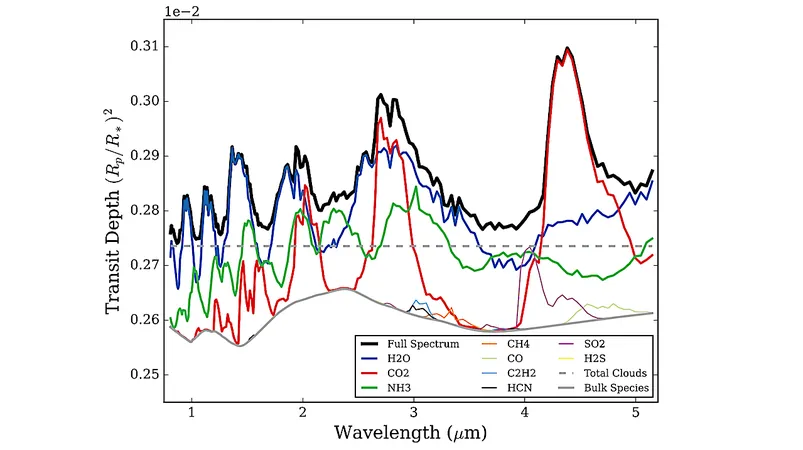
Groundbreaking Discovery of Water and Carbon Dioxide in the Atmosphere of WASP-166b
2025-01-03
Author: Nur
Introduction
In a remarkable advancement in exoplanetary science, researchers have successfully characterized the atmosphere of the hot super-Neptune WASP-166b, a planet with intriguing features orbiting an F9V star. Utilizing advanced observational techniques including JWST transmission spectroscopy with NIRISS SOSS Order-1 and NIRSpec BOTS G395M/F290LP, scientists have gathered compelling data regarding the planet’s atmospheric composition.
WASP-166b's Characteristics
WASP-166b, characterized by a period of 5.44 days, a radius approximately 6.9 times that of Earth, and a mass of 32.1 Earth masses, sits tantalizingly close to the edge of the so-called 'Hot Neptune Desert,' an area in the parameter space where planets of intermediate sizes are surprisingly sparse despite high levels of insolation. This uniqueness makes WASP-166b an intriguing subject for understanding the formation and evolutionary processes that govern planetary atmospheres under intense stellar radiation.
Atmospheric Composition
The joint spectrum data spans wavelengths from 0.85 to 5.17 micrometers (GO ID 2062), and the analysis has confirmed the presence of water (H2O) in the atmosphere with a significance of 15.2σ, while carbon dioxide (CO2) was detected for the first time with a significance of 14.7σ. Other notable findings include a tentative indication of ammonia (NH3) and an intermediate-pressure cloud deck, with their respective significances of 2.3σ and 2.6σ. However, the research also highlighted the absence of other common atmospheric molecules such as methane (CH4), carbon monoxide (CO), acetylene (C2H2), hydrogen cyanide (HCN), sulfur dioxide (SO2), and hydrogen sulfide (H2S).
Metallicity and C/O Ratio
Deepening the significance of this discovery, the researchers measured a high atmospheric metallicity of log(Z) = 1.57+0.17−0.18, indicating the planet has a substantial amount of heavy elements compared to hydrogen and helium. Additionally, they calculated a potentially substellar carbon-to-oxygen (C/O) ratio of 0.282+0.078−0.053 in contrast with the star's C/O ratio of 0.41±0.08, suggesting a complex formation history involving planetesimal accretion that could shed light on the processes leading to the Hot Neptune Desert.
Conclusion
With findings that enhance our understanding of atmospheric compositions under extreme conditions, WASP-166b exemplifies the future of exoplanet exploration. As scientists continue to delve into the atmospheres of distant worlds, each revelation adds a piece to the cosmic puzzle of planetary formation and evolution. The ongoing advancements in telescope technology promise even more groundbreaking discoveries in the near future. Stay tuned for more celestial insights!





 Brasil (PT)
Brasil (PT)
 Canada (EN)
Canada (EN)
 Chile (ES)
Chile (ES)
 Česko (CS)
Česko (CS)
 대한민국 (KO)
대한민국 (KO)
 España (ES)
España (ES)
 France (FR)
France (FR)
 Hong Kong (EN)
Hong Kong (EN)
 Italia (IT)
Italia (IT)
 日本 (JA)
日本 (JA)
 Magyarország (HU)
Magyarország (HU)
 Norge (NO)
Norge (NO)
 Polska (PL)
Polska (PL)
 Schweiz (DE)
Schweiz (DE)
 Singapore (EN)
Singapore (EN)
 Sverige (SV)
Sverige (SV)
 Suomi (FI)
Suomi (FI)
 Türkiye (TR)
Türkiye (TR)
 الإمارات العربية المتحدة (AR)
الإمارات العربية المتحدة (AR)